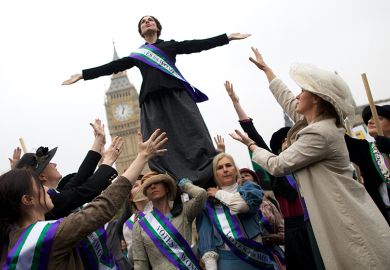Near the beginning of Introduction to Feminist Jurisprudence , Hilaire Barnett notes: "Feminist jurisprudence is both simultaneously challenging and alternative." Within the 1,000 pages that comprise these companion texts, Barnett successfully provides an introduction to an area of legal scholarship that is deserving of this description for its breadth, creativity and vision. A title that perhaps deserves volumes, this introductory text manages nonetheless successfully to lead the reader from Plato to postmodernism.
The structure of the introduction is thoughtfully managed. The concise but detailed journey begins, after a helpful orienting introduction, with the foundations of feminism. These foundations are explored in Part One by providing a - perhaps eclectic - summary of cultural/historical moments (from Chinese footbinding to European witch murders), moving on to note landmarks in the struggle for equality, before providing an overview of the position of women in contemporary society.
Part Two introduces conventional (male-stream?) jurisprudence and feminist critique. Central is the discussion of schools of feminist jurisprudential thought in the third section.
Here Barnett, while recognising the limitations of such a taxonomy, discusses the contributions made by liberal, Marxist-socialist, cultural, radical and postmodern feminists.
In the final section the volume considers key issues: health care, violence, pornography and prostitution. This final section gives a clear sense of the depth of feminist work in these areas, although some areas are notably stronger than others. Within the two texts, Barnett explores key ideas and moments in feminist (legal) theory and activism. The volumes discuss, among other things, patriarchy, the public/ private divide, the sameness/ difference debate, and the recurring issue of essentialism.
The two volumes are very much "parallel texts". Key material referred to in the introduction is reprinted in extracts of differing lengths in the Sourcebook on Feminist Jurisprudence . While the texts run more or less in parallel, there are some differences. International law, for example, is to an extent incorporated within the body of the introduction. In the sourcebook it forms the (perhaps symbolic) final chapter.
Has Barnett been too ambitious? In both texts, particularly the introduction, there is an initial sense that breadth has been pursued at the expense of depth. In chapter seven, "Schools of feminist thought: II, difference feminism/cultural feminism", Barnett surveys the contribution of psychologist Carol Gilligan, and then provides an introduction to French feminism in all of three pages. Later, in the same chapter, Drucilla Cornell's contribution is assessed in two pages. Yet in between lie 12 pages that provide a detailed and valuable introduction to the work of Luce Irigaray.
While it could be imagined that this reflects the author's theoretical bias or research interests, I have the sense that it reflects a recognition of the common perception of Irigaray's work as difficult, and is an attempt to allow the reader to enter her intellectual world for the reward and insight it will afford. In other words, Barnett has attempted to provide a real introduction, giving both breadth and well-judged moments of depth.
In the preface to the sourcebook, Barnett states that her intention was to provide a "working tool" for students. These companion texts will certainly be of use to students across a number of disciplines, not just law. They will, in particular, provide a valuable resource for students studying modules in women and the law, law and body politics , gender and the law, health-care law and jurisprudence. They will also form an accessible introduction and reference point to accompany the developing Cavendish series Feminist Perspectives.
Michael Thomson is lecturer in law, Keele University.
Introduction to Feminist Jurisprudence. First Edition
Author - Hilaire Barnett
ISBN - 1 85941 237 8
Publisher - Cavendish
Price - £14.95
Pages - 349
Register to continue
Why register?
- Registration is free and only takes a moment
- Once registered, you can read 3 articles a month
- Sign up for our newsletter
Subscribe
Or subscribe for unlimited access to:
- Unlimited access to news, views, insights & reviews
- Digital editions
- Digital access to THE’s university and college rankings analysis
Already registered or a current subscriber?



